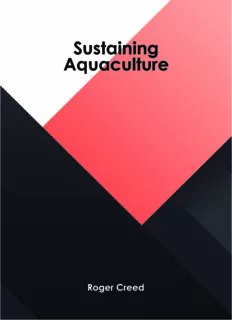
Sustaining Aquaculture PDF
Preview Sustaining Aquaculture
Sustaining Aquaculture Roger Creed Sustaining Aquaculture "This page is Intentionally Left Blank" Sustaining Aquaculture Edited by Roger Creed Published by Academic Pages, 5 Penn Plaza, 19th Floor, New York, NY 10001, USA Sustaining Aquaculture Edited by Roger Creed © 2017 Academic Pages International Standard Book Number: 978-1-9789-2919-7 This book contains information obtained from authentic and highly regarded sources. Copyright for all individual chapters remain with the respective authors as indicated. A wide variety of references are listed. Permission and sources are indicated; for detailed attributions, please refer to the permis- sions page. Reasonable efforts have been made to publish reliable data and information, but the au- thors, editors and publisher cannot assume any responsibility for the validity of all materials or the consequences of their use. Copyright of this ebook is with Academic Pages, rights acquired from the original print publisher, Callisto Reference. The publisher’s policy is to use permanent paper from mills that operate a sustainable forestry policy. Furthermore, the publisher ensures that the text paper and cover boards used have met acceptable environmental accreditation standards. Trademark Notice: Registered trademark of products or corporate names are used only for explanation and identification without intent to infringe. Contents Preface IX Part 1 Parasitic Diseases 1 Chapter 1 Metazoan Parasites of the European Sea Bass Dicentrarchus labrax (Linnaeus 1758) (Pisces: Teleostei) from Corsica 3 Laetitia Antonelli and Bernard Marchand Chapter 2 Parasitic Diseases in Cultured Marine Fish in Northwest Mexico 23 Emma J. Fajer-Ávila, Oscar B. Del Río-Zaragoza and Miguel Betancourt-Lozano Chapter 3 Transmission Biology of the Myxozoa 55 Hiroshi Yokoyama, Daniel Grabner and Sho Shirakashi Part 2 Bacterial Diseases 95 Chapter 4 An Overview of Virulence-Associated Factors of Gram-Negative Fish Pathogenic Bacteria 97 Jessica Méndez, Pilar Reimundo, David Pérez-Pascual, Roberto Navais, Esther Gómez, Desirée Cascales and José A. Guijarro Chapter 5 Molecular Detection and Characterization of Furunculosis and Other Aeromonas Fish Infections 121 Roxana Beaz Hidalgo and María José Figueras Part 3 Antibiotics and Probiotics 157 Chapter 6 The Use of Antibiotics in Shrimp Farming 159 M.C. Bermúdez-Almada and A. Espinosa-Plascencia ________________ WORLD TECHNOLOGIES ________________ VI Contents Chapter 7 Antibiotics in Aquaculture – Use, Abuse and Alternatives 175 Jaime Romero, Carmen Gloria Feijoó and Paola Navarrete Chapter 8 Probiotics in Aquaculture of Kuwait – Current State and Prospect 215 Ahmed Al-marzouk and Azad I. Saheb Chapter 9 Probiotics in Aquaculture – Benefits to the Health, Technological Applications and Safety 237 Xuxia Zhou and Yanbo Wang Part 4 Applied Topics of Cellular and Molecular Biology 249 Chapter 10 Use of Microarray Technology to Improve DNA Vaccines in Fish Aquaculture – The Rhabdoviral Model 251 P. Encinas, E. Gomez-Casado, A. Estepa and J.M. Coll Chapter 11 Bacteriocins of Aquatic Microorganisms and Their Potential Applications in the Seafood Industry 277 Suphan Bakkal, Sandra M. Robinson and Margaret A. Riley Chapter 12 Fighting Virus and Parasites with Fish Cytotoxic Cells 303 M. Ángeles Esteban, José Meseguer and Alberto Cuesta Chapter 13 The Atlantic Salmon (Salmo salar) Vertebra and Cellular Pathways to Vertebral Deformities 329 Elisabeth Ytteborg, Jacob Torgersen, Grete Baeverfjord and Harald Takle Part 5 Ecological Impacts of Fish Farming 359 Chapter 14 Ecological Features of Large Neotropical Reservoirs and Its Relation to Health of Cage Reared Fish 361 Edmir Daniel Carvalho, Reinaldo José da Silva, Igor Paiva Ramos, Jaciara Vanessa Krüger Paes, Augusto Seawright Zanatta, Heleno Brandão, Érica de Oliveira Penha Zica, André Batista Nobile, Aline Angelina Acosta and Gianmarco Silva David ________________ WORLD TECHNOLOGIES ________________ Contents VII Part 6 Work-Related Hazards – Prevention and Mitigation 383 Chapter 15 Aquacultural Safety and Health 385 Melvin L. Myers and Robert M. Durborow Part 7 Spread of Pathogens from Marine Cage 401 Chapter 16 Spread of Pathogens from Marine Cage Aquaculture – A Potential Threat for Wild Fish Assemblages Under Protection Regimes? 403 Antonio Terlizzi, Perla Tedesco and Pierpaolo Patarnello Permissions List of Contributors ________________ WORLD TECHNOLOGIES ________________ "This page is Intentionally Left Blank" ________________ WORLD TECHNOLOGIES ________________ Preface The main aim of this book is to educate learners and enhance their research focus by presenting diverse topics covering this vast field. This is an advanced book which compiles significant studies by distinguished experts in the area of analysis. This book addresses successive solutions to the challenges arising in the area of application, along with it; the book provides scope for future developments. Aquaculture has been growing rapidly, and future advancements will rely on the integration of scientific knowledge of varied fields such as molecular and cellular biology, and ecology. Comprehending the link between farmed species and their pathogens and parasites can be significantly challenging to environment. Scientists are making continual efforts to build a model for aquaculture that does not harm environment and offers a dependable source of healthy seafood. This book has been well described and comprises of contributions from prominent global authors, providing rich quality scientific topics focusing on important issues for successful health management of cultured aquatic animals. This collective effort has been aimed at providing extensive information useful for both educational and industrial sectors. It was a great honour to edit this book, though there were challenges, as it involved a lot of communication and networking between me and the editorial team. However, the end result was this all-inclusive book covering diverse themes in the field. Finally, it is important to acknowledge the efforts of the contributors for their excellent chapters, through which a wide variety of issues have been addressed. I would also like to thank my colleagues for their valuable feedback during the making of this book. Editor ________________ WORLD TECHNOLOGIES ________________
Description: